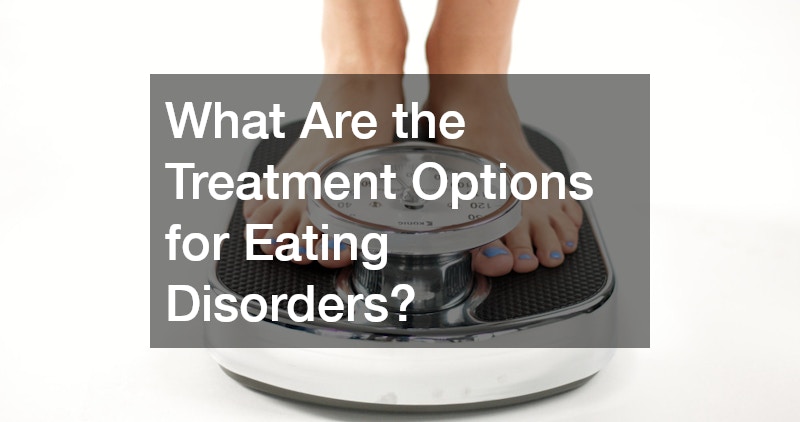Eating disorders are complex mental health conditions that can have severe physical and emotional consequences. They often involve a preoccupation with food, weight, and body image, leading to unhealthy eating behaviors. Common eating disorders include anorexia nervosa, bulimia nervosa, and binge eating disorder, each requiring specialized treatment approaches. The goal of treatment is to address the underlying psychological issues, correct unhealthy eating habits, and promote healthier coping mechanisms. Here, we will explore the main treatment options for eating disorders, from therapy and medication to support groups and nutritional counseling.
1. Psychotherapy (Talk Therapy)
Psychotherapy is considered the cornerstone of treatment for eating disorders. Therapy helps individuals understand and address the emotional, psychological, and behavioral factors contributing to their eating disorder. Several therapeutic approaches are effective in treating these conditions, including:
Cognitive Behavioral Therapy (CBT): CBT is one of the most commonly used therapies for eating disorders. This approach focuses on identifying and changing negative thought patterns that influence eating behaviors. For example, it helps individuals challenge distorted perceptions of their bodies and food, teaching healthier ways to cope with stress, emotions, and triggers that lead to disordered eating.
Dialectical Behavior Therapy (DBT): DBT is a form of cognitive-behavioral therapy that emphasizes mindfulness, emotional regulation, and distress tolerance. It is particularly useful for individuals who struggle with extreme emotions and impulsive behaviors, which can often lead to disordered eating.
Interpersonal Therapy (IPT): IPT focuses on improving interpersonal relationships and communication. Since many individuals with eating disorders experience difficulties with relationships, addressing these issues can reduce emotional distress and help prevent the development of eating-related problems.
Family-Based Therapy (FBT): Also known as the Maudsley Approach, FBT is often used for children and adolescents with eating disorders, especially anorexia nervosa. This approach involves the family in the treatment process, empowering parents to take an active role in their child’s recovery. It has been shown to be highly effective in helping young individuals overcome eating disorders.
2. Nutritional Counseling
Nutritional counseling is a vital component of eating disorder treatment, as it helps individuals restore healthy eating patterns and develop a balanced relationship with food. Registered dietitians specializing in eating disorders work with patients to develop personalized meal plans that address nutritional deficiencies caused by restrictive eating, purging, or binging.
Nutritional counseling often involves:
Education on balanced nutrition: Helping individuals understand the importance of balanced meals that provide adequate nutrients and energy to the body.
Addressing food fears and anxieties: Many individuals with eating disorders experience intense fear around certain foods or eating in general. Nutritional counseling helps to gradually reintroduce these foods in a safe and supportive environment.
Mindful eating practices: Teaching individuals how to listen to their body’s hunger and fullness cues, allowing them to eat intuitively without the pressure of dieting or restricting.
3. Medication
While therapy and nutritional counseling are the primary treatment options, medications can be prescribed in some cases to address underlying mental health conditions such as anxiety, depression, or obsessive-compulsive disorder (OCD), which often co-occur with eating disorders.
Antidepressants: Selective serotonin reuptake inhibitors (SSRIs), a class of antidepressants, are commonly prescribed for individuals with bulimia nervosa, binge eating disorder, and anorexia nervosa. SSRIs help to alleviate symptoms of depression, anxiety, and obsessive thoughts, which may reduce the frequency of disordered eating behaviors.
Antipsychotic medications: These may be prescribed for individuals with severe anorexia nervosa, especially those who experience significant cognitive distortions or an inability to see the severity of their illness. Medications like olanzapine may help individuals gain weight and improve their psychological state.
Other medications: In some cases, medications that help manage impulsivity, anxiety, or OCD may also be helpful. For example, stimulants may be used to reduce symptoms of binge eating disorder or hyperactivity in certain individuals.
Medication is typically used in conjunction with therapy and nutritional support to provide a comprehensive treatment plan.
4. Inpatient and Residential Treatment Programs
In some cases, eating disorders can become so severe that outpatient treatment is no longer sufficient. Individuals who are at risk of medical complications due to malnutrition, extreme weight loss, or purging may require intensive treatment in an inpatient or residential facility.
Inpatient treatment: Inpatient programs provide 24-hour care for individuals with severe eating disorders. These programs focus on medical stabilization, nutrition rehabilitation, and therapy. Inpatients are closely monitored to ensure their safety and address any immediate medical needs.
Residential treatment: Residential programs are less intensive than inpatient care but still provide structured treatment in a supportive environment. Individuals live in the treatment facility and receive therapy, nutritional counseling, and other necessary services. These programs are ideal for individuals who need help managing their eating disorder but do not require constant medical supervision.
5. Support Groups and Peer Support
Support groups play a crucial role in the recovery process. They provide a sense of community and allow individuals to connect with others who understand the challenges of living with an eating disorder. Peer support offers emotional encouragement, which can be vital for individuals during difficult times in their recovery journey.
Eating Disorder Anonymous (EDA): Similar to Alcoholics Anonymous, EDA is a 12-step program that helps individuals with eating disorders share their experiences and support one another through the recovery process.
Group therapy: Group therapy sessions are often used in conjunction with individual therapy. These sessions provide a safe space for individuals to discuss their experiences, challenges, and progress with others who are in similar situations.
Watch the video above to learn more and see if online eating disorder treatment is right for you.
.


